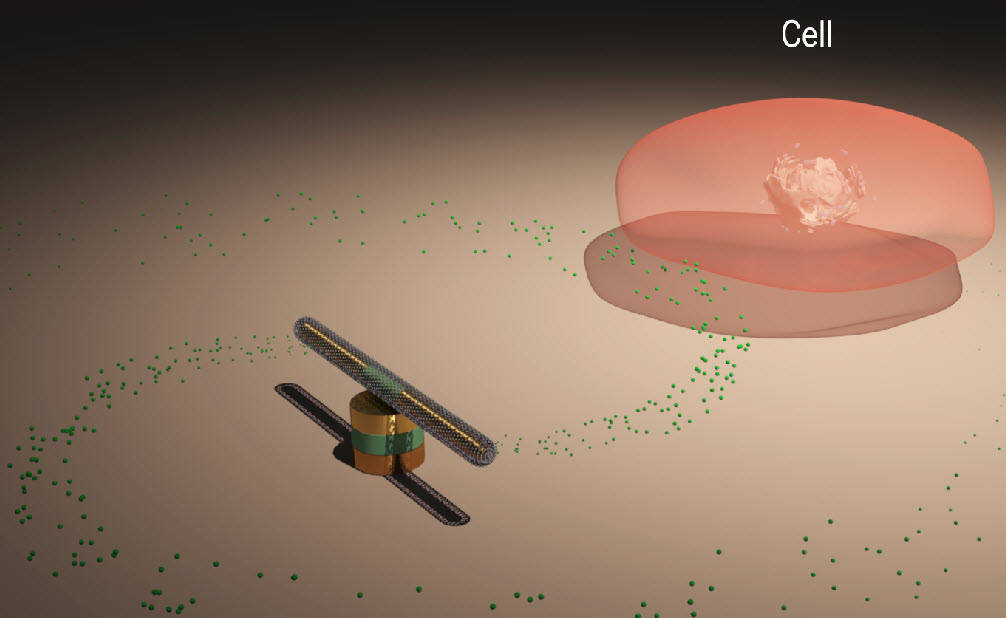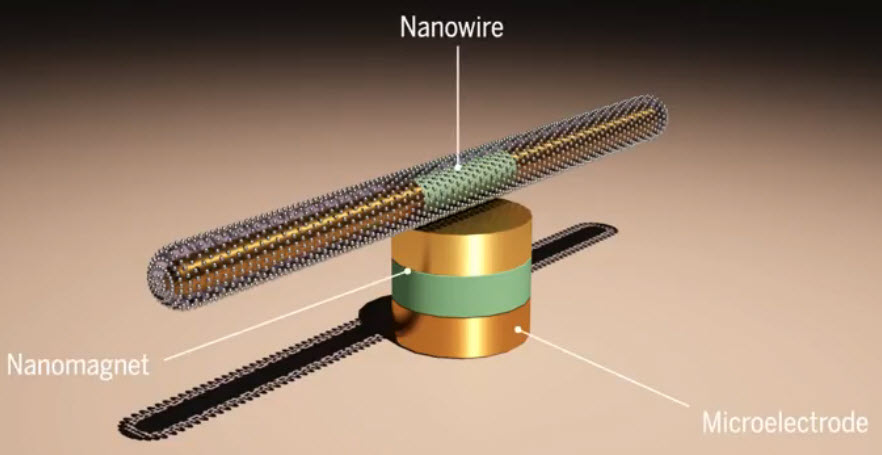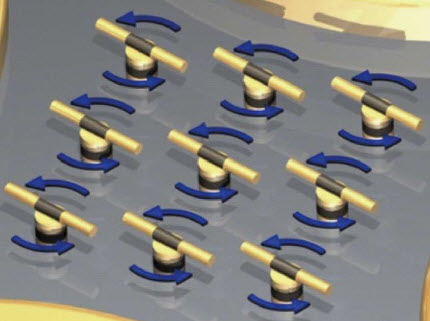World’s smallest, fastest nanomotor
May 21, 2014

Nanomotor could control the speed and rate of drug delivery to a specific cell (credit: Cockrell School of Engineering, The University of Texas at Austin)
Researchers at The University of Texas at Austin have built the “smallest, fastest, and longest-running” nanomotor to date — an important step toward developing miniature machines that could one day move through the body to deliver drugs such as insulin for diabetics when needed, or target and treat cancer cells without harming good cells, the scientists say.
Led by Cockrell School of Engineering mechanical engineering assistant professor Donglei “Emma” Fan, UT Austin engineers focused on building a reliable, ultra-high-speed nanomotor that can convert electrical energy into mechanical motion on a size scale 500 times smaller than a grain of salt.
The team’s three-part nanomotor can rapidly mix and pump biochemicals and move through liquids, which is important for future applications. The team’s study was published in the April issue of Nature Communications.
Cockrell School of Engineering assistant professor Donglei (Emma) Fan and her mechanical engineering team have built the fastest, smallest nanomotor to date.
To test its ability to release drugs, the researchers coated the nanomotor’s surface with biochemicals and initiated spinning. “We were able to establish and control the molecule release rate by mechanical rotation, which means our nanomotor is the first of its kind for controlling the release of drugs from the surface of nanoparticles,” Fan said. “We believe it will help advance the study of drug delivery and cell-to-cell communications.”
How to assemble a nanomotor bottom-up

A nanomotor bottom-up-assembled from nanoscale building blocks, with gold-nickel nanowires as rotor, tri-layer gold-nickel-chromium nanomagnet as bearing, and microelectrode as stator (credit: Kwanoh Kim et al./Nature Communications)
Fan and her team are the first to achieve the extremely difficult goal of designing a nanomotor with large driving power.
With all of its dimensions under 1 micron (millionth of a meter, or 1000 nanometers) in size, the nanomotor could fit inside a human cell and is capable of rotating for 15 continuous hours at a speed of 18,000 RPMs, the speed of a motor in a jet airplane engine. Comparable nanomotors run significantly more slowly, from 14 RPMs to 500 RPMs, and have only rotated for a few seconds up to a few minutes.
The researchers addressed two major issues for nanomotors so far: assembly and controls. The team built and operated the nanomotor using a patent-pending technique that Fan invented while studying at Johns Hopkins University. The technique relies on AC and DC electric fields to assemble the nanomotor’s parts one by one.

Schematic diagram of an array of nanomotors synchronously rotated with controlled angle, speed and chirality at 18,000 rpm or more (credit: Kwanoh Kim et al./Nature Communications)
In experiments, the researchers used the technique to turn the nanomotors on and off and propel the rotation either clockwise or counterclockwise. The researchers found that they could position the nanomotors in a pattern and move them in a synchronized fashion, which makes them more powerful and gives them more flexibility.
Looking forward, nanomotors could advance the field of nanoelectromechanical systems (NEMS), an area focused on developing miniature machines that are more energy-efficient and less expensive to produce. The researchers believe their nanomotors could provide a new approach to controlled biochemical drug delivery to live cells in the near future.
Fan and her team plan to develop new mechanical controls and chemical sensing that can be integrated into nanoelectromechanical devices. But first they plan to test their nanomotors near a live cell, which will allow for measuring how the nanomotors deliver molecules in a controlled fashion.
The National Science Foundation Career Award, the Welch Foundation, and startup funds from the Cockrell School supported the study.
Abstract of Nature Communications paper
The development of rotary nanomotors is crucial for advancing nanoelectromechanical system technology. In this work, we report design, assembly and rotation of ordered arrays of nanomotors. The nanomotors are bottom-up assembled from nanoscale building blocks with nanowires as rotors, patterned nanomagnets as bearings and quadrupole microelectrodes as stators. Arrays of nanomotors rotate with controlled angle, speed (over 18,000 r.p.m.), and chirality by electric fields. Using analytical modelling, we reveal the fundamental nanoscale electrical, mechanical and magnetic interactions in the nanomotor system, which excellently agrees with experimental results and provides critical understanding for designing metallic nanoelectromechanical systems. The nanomotors can be continuously rotated for 15 h over 240,000 cycles. They are applied for controlled biochemical release and demonstrate releasing rate of biochemicals on nanoparticles that can be precisely tuned by mechanical rotations. The innovations reported in this research, from concept, design and actuation to application, are relevant to nanoelectromechanical system, nanomedicine, microfluidics and lab-on-a-chip architectures.